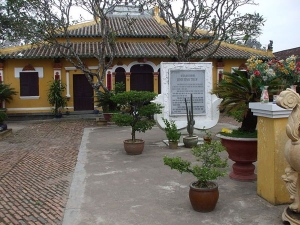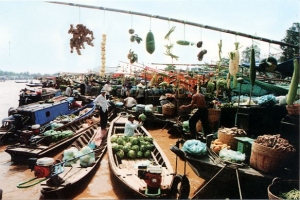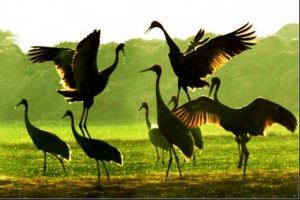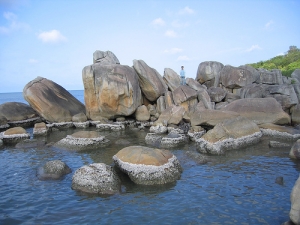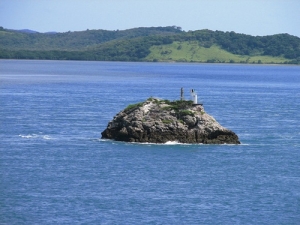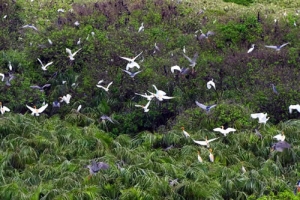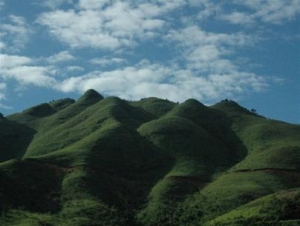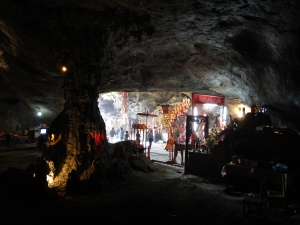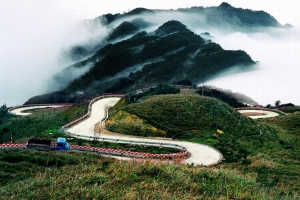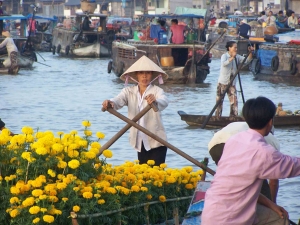
Asia Pacific Travel Team
Can Tho City’s Long Tuyen Ancient Village
This is an old village in the south of Can Tho City, including Binh Thuy, An Thoi, Long Tuyen and Long Hoa. The village is a destination that attracts many tourists in Vietnam travel not only because of its beautifully natural scenery, but also the cultural relics that remains after hundreds of years.
The architecture and culture in Long Tuyen is very unique because it is the combination of various cultures from Western to Eastern, including Chinese, French, American, Cham and Japanese. This place also possesses six of 18 national relics in Can Tho, including famous locations such as Binh Thuy Temple, Nam Nha Pagoda or Binh Thuy Old House. Moreover, the Ky Yen Festival takes place here.
It can be said that Long Tuyen village is a rare destination that contains various typical characteristics of the culture in this region, and for sure it is a pity if you don’t add this destination to your travel.
Cai Rang Floating Market- A Great Place for Tourists Traveling to Can Tho City
One of the most interesting sights in the Delta is the floating markets and associated river life. Cai Rang Floating Market is open all day but it is busiest from sunrise to about 9am. The main items sold there are farm products and specialties of Cai Rang Town, Chau Thanh District and neighboring areas. Every boat has a long upright pole at its bow on which samples of the goods for sale are hung.
During the early morning market hours, larger sized boats anchor and create lanes that smaller boats weave in and out of. The waterway becomes a maze of hundreds of boats packed with mango, bananas, papaya, pineapple, and even smuggled goods like cigarettes. Sellers do not have to cry out about their goods because their goods can be seen in a distance and their cries would not be heard in the vastness of the river and the noise of boat engines. Small boats that sell beer, wine and soft drinks go among the other boats to serve market-goers and visitors in Vietnam travel. Sellers tie their goods to a tall pole so that buyers can see from a distance what they are selling.

Foreign visitors are very excited when visiting Cai Rang Floating Market
Each boat is loaded with plenty of seasonal goods. Activities at the market are also an occasion for tourists to study the cultural aspects of southerners. You can see the market in the distance; it does not look like much, just a mass of boats. The boats all display their wares on a mast so you can see what they have available.
Coming to Cai Rang Floating Market, tourists in Vietnam travel can join a tour of the Mekong Delta. On the way to Can Tho, tourists can stop to visit My Tho and take a boat trip to visit orchards, bee farms and coconut candy establishments in Ben Tre.
If you are joining tours in Vietnam and to vist Can Tho City, let’s take a 30 minute boat ride to the market. You will be actually awake and enjoying it! You wiill find it very peaceful floating down the river in the early morning and you will feel how great the floating market is!
Discover Tram Chim National Park – A rich and diverse eco-tourism destination in Vietnam tourism
Topography and hydrology
Tram Chim National Park is located 19 km to the east of the Mekong River, at an elevation of about 1m. The topography of the national park is flat, slopes slightly to the East. In the past, several natural streams and rivers flowed from west to east, distributing water from the Mekong River to the plain of reeds. Now, these streams and rivers have been replaced by a system of canals flowing through the national park.
Prior to canalization, the plain of reeds was seasonally flooded with standing water for continuous periods of up to seven months per year. Since canalization, flood waters drain more rapidly and the national park is flooded for less than six months per year. Water levels in the canals begin to rise in June, at the beginning of the rainy season. Between September and December, the national park is inundated to a depth of 2 to 4 m, with a peak in October.
Since the mid-1980s, 53 km of dykes fitted with sluices have been constructed around the national park, with the aim of impounding floodwater for longer as well as reducing the lowering of the water table during the dry season. The national park is fragmented by canals into five management zones; the water level of each can be managed separately.
Biodiversity values
 The vegetation of Tram Chim National Park comprises a mixture of seasonally inundated grassland, regenerating Melaleuca forest and open swamp. Melaleuca is distributed throughout the national park, both in plantations and in scattered patches in areas of grassland or open swamp. There are five widespread grassland communities at Tram Chim, of which the community dominated by Eleocharis dulcis and wild rice Oryza rufipogon is of the highest conservation significance. Tram Chim is one of the few places in the Plain of Reeds where community is likely to survive to any extent, and, therefore, one of the most important sites for the conservation of wild rice in Vietnam. The other grassland communities are dominated by Eleocharis ochrostachys, Panicum repens, Ischaemum rugosum and Vossia cuspidata.
The vegetation of Tram Chim National Park comprises a mixture of seasonally inundated grassland, regenerating Melaleuca forest and open swamp. Melaleuca is distributed throughout the national park, both in plantations and in scattered patches in areas of grassland or open swamp. There are five widespread grassland communities at Tram Chim, of which the community dominated by Eleocharis dulcis and wild rice Oryza rufipogon is of the highest conservation significance. Tram Chim is one of the few places in the Plain of Reeds where community is likely to survive to any extent, and, therefore, one of the most important sites for the conservation of wild rice in Vietnam. The other grassland communities are dominated by Eleocharis ochrostachys, Panicum repens, Ischaemum rugosum and Vossia cuspidata.
The Park is in the lowest area of the Mekong River water logged plain submerged and in the centre of Dong Thap Muoi. With a system of swamps, grass-plots and crossing canals, the 7,612 ha Tram Chim National Park has become an ideal habitat of more than 100 vertebrates, 40 species of fish, and 147 rare and precious species of birds, especially the red-head cranes. Hence, it is also an ideal place for scientists to research into the life of migratory birds. To date, at least 88 bird species have been recorded at Tram Chim National Park. The site is famous for the population of Sarus Cranes that inhabits the site in the dry season. In 1990s, hundreds of Cranes spent the dry season here. However, due to some inappropriate development in late 1990s and early 2000s, maximum counts of cranes fell dramatically to some 82 birds in the 2005 dry season. In addition to Sarus Crane, the globally endangered Bengal Florican Houbaropsis bengalensis has also been recorded at Tram Chim National Park. The status of this secretive grassland specialist at Tram Chim is not fully known but it is likely that birds vacate the area during periods of substantial inundation in the late wet season. Local people believe that the species breeds at the site, and claim to have found both eggs and young of the species but this has yet to be confirmed. A number of other globally threatened and near-threatened bird species regularly occur at Tram Chim, including Oriental Darter Anhinga melanogaster, Lesser Adjutant Leptoptilos javanicus, Painted Stork Mycteria leucocephala and Asian Golden Weaver Ploceus hypoxanthus.
Other wetland bird species of note recorded at Tram Chim include Cotton Pygmy Goose Nettapus coromandelianus, Greater Painted-snipe Rostratula benghalensis and Pheasant-tailed Jacana Hydrophasianus chirurgus. Because of its importance for globally threatened and bird species, Tram Chim qualifies as an Important Bird Area.

Efforts to conserve.
In 1985 when red-head cranes appeared in Tram Chim National Park, scientists held a workshop in China to find out measures to preserve them and develop Tram Chim National Park in Tam Nong Natural Site into a typical cultural and ecological tourist area in Southeast Asia.
Since then, many international organizations have participated in researching into red-head cranes in Tram Chim, including the World Wildlife Fund (WWF), the International Union for the Conservation of Nature and Natural Resource (IUCN) and others.
In February 1994, Tram Chim officially became the national nature conserve zone under the Prime Minister’s decision, where the State invested more than VND 4bil, the Bhrem Fund of Germany granted US$15,000 and the UK and Danish Embassy donated US$ 60,000 to the protection of the “Red-head cranes’ house” and the improvement of Tram Chim’s buffer zone.
In 1995, ICF wanted to conduct surveys on the breeding sites of red-head cranes and in March 1998, scientists began putting electronic tracking rings worth US$10,000 on cranes to observe their migration and reproduction. The activity was funded by the Japanese Government with the participation of American, Japanese and Vietnamese scientists. The signals received from red-head cranes provide good information for scientists to research into the red-head cranes’ migration and reproduction.
Leaving out this park is an actual pity!
Tram Chim is 40 km by road from Cao Lanh town in Dong Thap province. Within the national park, you can hire boats to reach good birding sites. From January to May each year, when sky is clear, visitors will see from the horizon many black spot coming. It is crane flock returning after months of emigrating to evade flood. This is also the season for photographing cranes in the dawn and sunset
Tram Chim National Park is one of the best developed and most well-known sites for ecotourism in the Mekong Delta. The national park already has basic tourist facilities, and previously received many visitors. There are some small guesthouses in Tam Nong town with basic facilities.
Tram Chim National Park, with natural history of collective ecology of geomorphology, hydrography and underwater creatures, is an ideal rendezvous place of tourists from all over the world.
Today, The Government of Vietnam has paid more attention to the renovation and investment the capital into The Tram Chim National Park in order for this national park of Dong Thap province to become a natural museum and an attractive eco-tourism site to tourists in Vietnam travel. Many international preservation organizations have also sponsored to help protecting the rare and valuable birds there from the extinction.
A natural rock-garden among the immense sea
It takes one and a half hours by motorbike from Ca Mau city to travel about 50km to Hon Da Bac linked to the mainland by a bridge. Tourists with Vietnam travel guide can also reach the island by canoe or ferry.
Seen from far, Hon Da Bac (Silver Stone Island) looks like a natural rock-garden among the immense sea. The island is divided into 4 peaks including 2 high peaks, 2 low peaks extending to the sea. Surrounded by many large granite rocks linking together which are covered by bushy branches of trees. Some rocks have weird shapes that people have named. San Tien (Fairy Yard) is a high hill with a yard whose area is about 50m2. The legend has it that in the old days, there were many fairies coming here to have a bath. In addition, there are the large and smooth rocks called Gieng Tien (Fairy Well), Ban Chan Tien (Fairy Foot) and Ban Tay Da (Stone Hand).
Most of trees in the island are mangos, bananas, guavas, and miscellaneous trees. Surroundinged by a lot of large rocks and small rocks creating a dreamlike and grandiose landscape. Climbing the cliffs and slipping away into the groves, many secrets of nature are worth discovering. Hon Da Bac is also home to several tourist attractions such as Hung Hue Pagoda, Ca Ong Temple.
Moreover, during the resistance war against American imperialist, Hon Da Bac was selected as the garrison of American troops to control revolution base of Khanh Binh Tay and coastal region in the west of Ca Mau. Khanh Binh Tay troops and people attacked and defeated this garrison. This island was also location of CM12 campaign to defeat the plot of Le Quoc Tuy and Mai Van Hanh intending to overthrow the socialist regime.
From September on, when the sea is the most beautiful with blue water and quiet waves, the tourists for Vietnam travel guide can stroll or join the locals in catching squid or diving to find oysters in their underwater caves. Sea oyster is unsmooth and thorny, living by staying close to rocks at the foot of the island in the depth of from 1m to 3m. In order to catch the oysters, the tourists must swim underwater in the sea, use hand-hammers to catch each one. The sea oysters are present at a lot of places, however according to a lot of gourmets, only the oysters in Hon Da Bac are most delicious and nourishing.
Hon Da Bac is an attractive destination for the tourists in Vietnam travel who want to return to the nature. You can sit on a granite rocks and enjoy the sunset or admire the moonlight while the waves lap the beach will not be forgotten
The natural landscapes of Hon Khoai Island
A path to the top of the island zigzags round the hillside and is shadowed by high and big trees. Jackfruit and mango trees are seen lush and many of them have become century-old trees. Various wild flowers blossom in rock cavities as though specially placed there as part of some artistic arrangement. The sound of running water and the chirping of birds complete a heavenly beauty. On the Hon Khoai coast, there are numerous algae used to cook delicious dishes. There are many species of birds, some of which such as: wild geese and swallows, have made Hon Khoai their home.
On the Hon Khoai coast, there are numerous algae which can be cooked into delicious dishes. There are also many species of birds on the island, including wild geese and swallows.
On the Hon Khoai Island stands an significant lighthouse in the Eastern Sea and Thailand Bay. Having invaded Vietnam, French colonialists built a system of lighthouses from Can Gio, Phu Quoc to Hon Khoai to lead ships. The architecturally intact 318 meter-high lighthouse on Hon Khoai Island, unfailingly puts on its best postcard behavior for visitors. Moreover, the lighthouse tower was one of the earliest construction sites on the Vietnamese territorial waters.
Bird yard in Ca mau City
Drived 4 km from Ca Mau, center towards Ly Van Lam Street is 19/5-bird yard. Being springtime, framework of bird yard more and more lyric, poetic. Each year, just on the occasion of Tet, birds gather here again as made a date long time ago.
Ca Mau, city in southern Vietnam is the capital of Ca Mau province, a province in the Mekong Delta region, in the southernmost part of Vietnam's inland territory.The city is characterized by its system of transport canals and most goods are transported here by boats and barges.
For Ca Mau people, bird yard is a pride, in near future, Ca Mau will be the first City which has a bird yard houses with resident. On holidays, especially on the occasion of Tet, birds yard brimful with laughter of tourists. Not an end, within the campus of bird yard also has Trau Cau restaurant, which was selected by many inseparated couples to organize their greatest happy day of the life. In a locality as Ca Mau, the establishment, maintainment and enlargement of such an attractive position is very appreciate, encouragable
The birds make their nests in tall trees and spend their mornings searching for food; the perfect opportunity for tourists to take out the cameras. Camau Tourist Company has a one-day bird-watching program by boat.

Mau Son Mountain- An Ideal Destination for Vacation and Holiday
Mau Son Mountain is located in Loc Binh District, about 30km from Lang Son City to Mau Son Rerort.
To the north is Ninh Minh, China, to the east is Na Duong and to the west is Dong Dang, all merging beautifully into one spectacular landscape. The winding narrow mountain path, like a snake, lies tucked between 2 steep mountains.

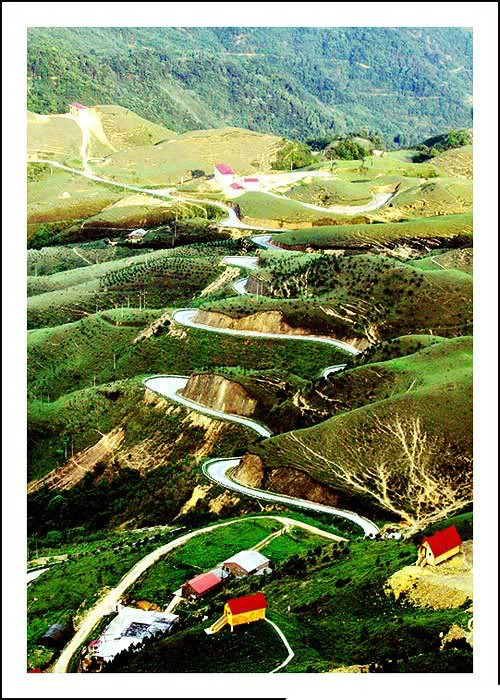 About seventy years ago before this path existed, there were only two ways to the top, walking or on horseback. At that time, this panoramic area attracted the French to Mau Son for relaxation. The weather was cool all year round and in addition, the Dear Mountain View of the northeast was the gateway to China, and the French built a military base there at the early of the 20th century to guard the border. The site's original inhabitants, members of the Dao ethnic minority, were moved to make way for the French settlement. Only authorized personnel were permitted to enter the French base.
About seventy years ago before this path existed, there were only two ways to the top, walking or on horseback. At that time, this panoramic area attracted the French to Mau Son for relaxation. The weather was cool all year round and in addition, the Dear Mountain View of the northeast was the gateway to China, and the French built a military base there at the early of the 20th century to guard the border. The site's original inhabitants, members of the Dao ethnic minority, were moved to make way for the French settlement. Only authorized personnel were permitted to enter the French base.
Later, tourists in Vietnam travel coming to Mau Son were also welcome to the hill station. In January 1936, Dr.O.Pflot, a student of the famous bacteriologist Dr. Alexandre Yersin, visited Mau Son. Some local people say that the doctor first came to Mau Son to collect traditional medicinal herbs, which were cultivated in die region. And then, he petitioned Mr Tholace, then French governor of the North, for permission to build tourist villas at the site. In 1936 he got the goaded to buy land and to start the construction.
There were thousands of local people working on the project, all mining, breaking and carrying stones to bad a number of massive villas, all in all it took seven years of work to accomplish this task. There were no bricks available to build with; the only materials available were stones, bled to ruins. Blocks of orange moss-covered stories are scattered throughout the site, lying dead amongst the old foundations, where even now, it is possible to identify the houses former kitchens, fireplaces and staircases.
Like sleeping beauty, after almost five decades, it was all but forgotten. Until 1987 motorbikes were not even allowed onto the torturous road up the mountain.
Mau Son will be developed to become a tourist area with mountain climbing, sightseeing, and recreation in the future.
Tam Thanh Grotto Enchants Tourists with Scenic Beauty
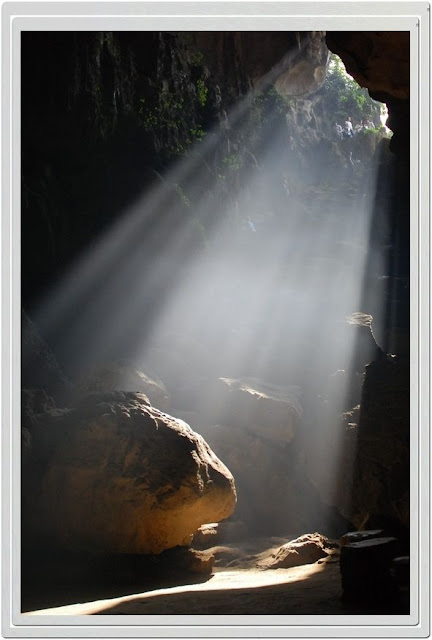 Lang Son is only 154km from Hanoi, and it takes another 14km to reach Dong Dang. This area is well-known for several beauty spots such as Tam Thanh grotto, Nhi Thanh grotto, Ky Lua Street, Ky Cung River, Vong Phu stone statue, etc., which have been attracting a large number of visitors in Vietnam travel. Among these, the name Tam Thanh has been very popular since it is the first destination on the route to the complex of Nhi Thanh – Tam Thanh of the land Lang Son.
Lang Son is only 154km from Hanoi, and it takes another 14km to reach Dong Dang. This area is well-known for several beauty spots such as Tam Thanh grotto, Nhi Thanh grotto, Ky Lua Street, Ky Cung River, Vong Phu stone statue, etc., which have been attracting a large number of visitors in Vietnam travel. Among these, the name Tam Thanh has been very popular since it is the first destination on the route to the complex of Nhi Thanh – Tam Thanh of the land Lang Son.
Upon reaching the grotto, you will see a small pagoda situated right outside the entrance gate. Different from other pagodas, this one attracts tourists for its unique and special beauty. The pagoda is constructed in 17th century with the name Tam Thanh Pagoda. Getting inside the grotto, visitors will reach the first part of Tam Thanh grotto, which is 60m long and nearly 30m wide. Tourists in Vietnam travel will be impressed by the thousand-year natural beauty of the scenery as they step in the second, the third part of the grotto. The deeper you move, the more surprised you will get.
Especially, Tam Thanh is featured by the Am Ty Lake lying right in the center of the grotto, which is always fully-filled with water. The lake is several tens square meters in area, but its landscape is far more captivating with abundant water source flowing around days and nights.
The modern combination of lights glisten the grotto and embellish the surrounding scenery. At the end of the grotto, tourists can move through a small path which leads up to a point. From there, tourists can enjoy the marvelous view over the new surrounding rural area.
Many famous poets of Vietnam had visited Tam Thanh Pagoda and left their autographs on the beauty of the land there.
Tam Thanh, the pagoda, the grotto along with the fascinating Am Ty Lake have charmed visitors who have once came there. The grotto will surely be your destination again in near future for its beauty and peaceful atmosphere.
Nhi Thanh Grotto- One of the Most Beautiful Grottos in Lang Son
 Nhi Thanh Grotto is situated in Nhi Thanh Street, approximately 1km from the Lang Son City, Lang Son province. It is home to the Pagoda of Triple Regions (Buddhism, Taoism, and Confucianism). The grotto was closely related to the celebrity Ngo Thi Si when he was the chief of province between 1777 and 1780. He gave, in a short span of time, a new look to Lang Son in term of politics, economy and national defense. Especially in the domain of culture, he had the merit to discover 8 beautiful landscapes of Lang country including Nhi Thanh Grotto. He hired workers to start the renovation of this grotto in 1779. The right side area, being on a relatively more elevated land and the configuration of terrain better, was chosen to be the place for the building of the Pagoda of Triple Regions (in honour of Confucianism, Taoism, Buddhism).
Nhi Thanh Grotto is situated in Nhi Thanh Street, approximately 1km from the Lang Son City, Lang Son province. It is home to the Pagoda of Triple Regions (Buddhism, Taoism, and Confucianism). The grotto was closely related to the celebrity Ngo Thi Si when he was the chief of province between 1777 and 1780. He gave, in a short span of time, a new look to Lang Son in term of politics, economy and national defense. Especially in the domain of culture, he had the merit to discover 8 beautiful landscapes of Lang country including Nhi Thanh Grotto. He hired workers to start the renovation of this grotto in 1779. The right side area, being on a relatively more elevated land and the configuration of terrain better, was chosen to be the place for the building of the Pagoda of Triple Regions (in honour of Confucianism, Taoism, Buddhism).
 Being a natural cave, Nhi Thanh Grotto lies beneath the Pagoda of Triple Regions, with the depth of 600 meters. On the cliffs at the entrance are 20 inscriptions that are precious historical and literary documents, including autographs of famous scholars. The statue of scholar Ngo Thi Sy on the cliff engraved in 1779 is a precious work of art. The length of a corridor from front entrance to back entrance is over 500 metres with many beautiful and picturesque landscapes. Inscriptions can be seen today on grotto, which were engraved by famous personalities and poets over different epochs.
Being a natural cave, Nhi Thanh Grotto lies beneath the Pagoda of Triple Regions, with the depth of 600 meters. On the cliffs at the entrance are 20 inscriptions that are precious historical and literary documents, including autographs of famous scholars. The statue of scholar Ngo Thi Sy on the cliff engraved in 1779 is a precious work of art. The length of a corridor from front entrance to back entrance is over 500 metres with many beautiful and picturesque landscapes. Inscriptions can be seen today on grotto, which were engraved by famous personalities and poets over different epochs.
Moreover, the grotto has numerous stalactites and stalagmites in different shapes, making the grotto look more grotesque and mystical. The entrance to the grotto is almost obscured from sunlight, because it is covered with dense foliage of trees. High on the wall to the right side of the entrance, there remains a poem carved deep into the stone. The poem was written by Ngo Thi Si (1726- 1780) when he was stationed in Lang Son as the commander of the Lang Son military post. Ngo Thi Si praised the beauty of the magnificent mountain and landscapes possessed by Lang Son. Ngo Thi Si was the person who discovered Nhi Thanh Grotto. The name Nhi Thanh was chosen by Ngo Thi Si to commemorate his birth place in Ta Thanh Oai village in Thanh Oai district, Hanoi. To commemorate his great contributions to the grotto, Ngo Thi Si had his portrait carved on an interior wall.
"Flows of clean pure white stream water run over hundreds of pieces of marble as if it is talking. Turn one's back to the stream and look up to a high mountain peak in the from can see the Vong Phu peak". Ngo Thi Si’s verses make you feel like to visit Lang Son’s beauty spots, and Nhi Thanh Grotto is one of the eight sites that attract a large number of visitors to Lang Son.
Unforgettable impressions when traveling to Can Tho city
Indeed, to attract more and more foreign customers, Smile Travel Vietnam is launching a lot of special promotion programs. Especially, it organizes many tours with at most 50% off. It is sure that tourists will have unforgettable experiences when traveling to Can Tho.
Can Tho has a reputation for being a welcoming place, where everybody is smiling and welcoming. Indeed, the local residents in the Mekong Delta often make a saying that goes:
"Can Tho, white rice, clear waters. All who comes wishes never to leave."
Can Tho city has a population over 1 million and is the biggest city in the Mekong Delta. Though its rapid development, the city retains its charm as the center of a rural area. The City is famous for its primitive landscapes, canals, ancient pagodas and of course historical homes. Moreover, it is bathed with the dense systems of rivers, arroyos and cannels that benefit the bumper harvests, travel navigation and commercial activities. It offers a wide range of tropical fruits such as jackfruit and durian, where visitors could be deep in abundant orchards.
Mentioning about Can Tho city, people will never forget the floating markets, where every good is exchanged on the river. Having the good tourism infrastructure, the healthy supply of eateries and a selection of floating markets, it is really worth visiting.
The main reason tourists come to Can Tho is to tour at floating markets. While these are highly recommended, the riverfront promenade itself is also pleasant with some good places to eat and relax in. The city has a good kind of accommodations from cheap backpacker haunts to comfortable mid-range digs. Spending one or two nights in Can Tho, seeing the floating markets independently and enjoying the riverside setting, tourists will have the most awesome feeling ever before.
Traveling to this wonder land will be much more interesting if tourists book tours in Can Tho with Smile Travel Vietnam. Travelers are offered a variety of tour packages from 1 day to 15 days. Just spending $73 - $179, tourists can enjoy Mekong Delta Cruise in 2 days and 1 night, departing from Ho Chi Minh City. There are many other interesting package tours are available on the website of Smile Travel Vietnam.


